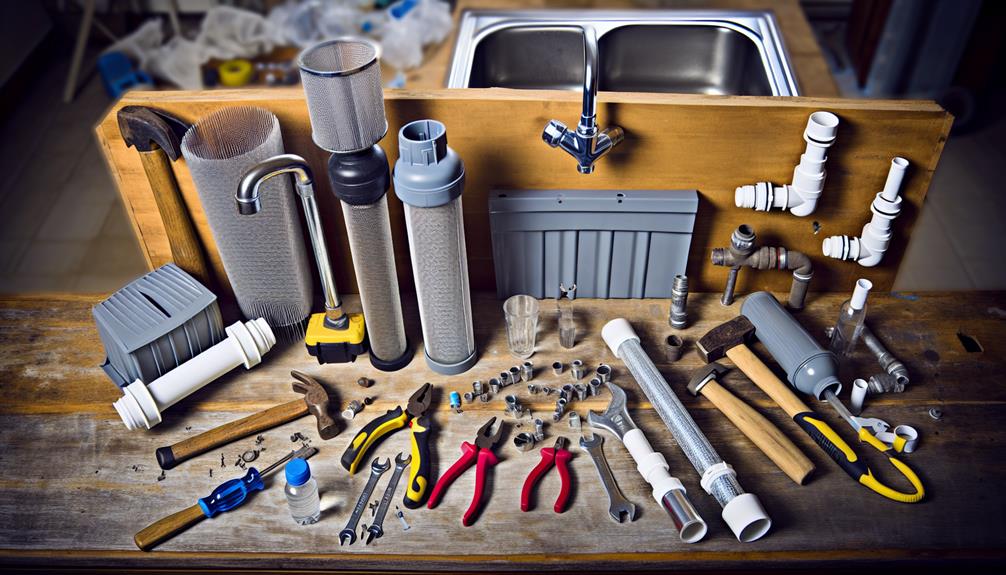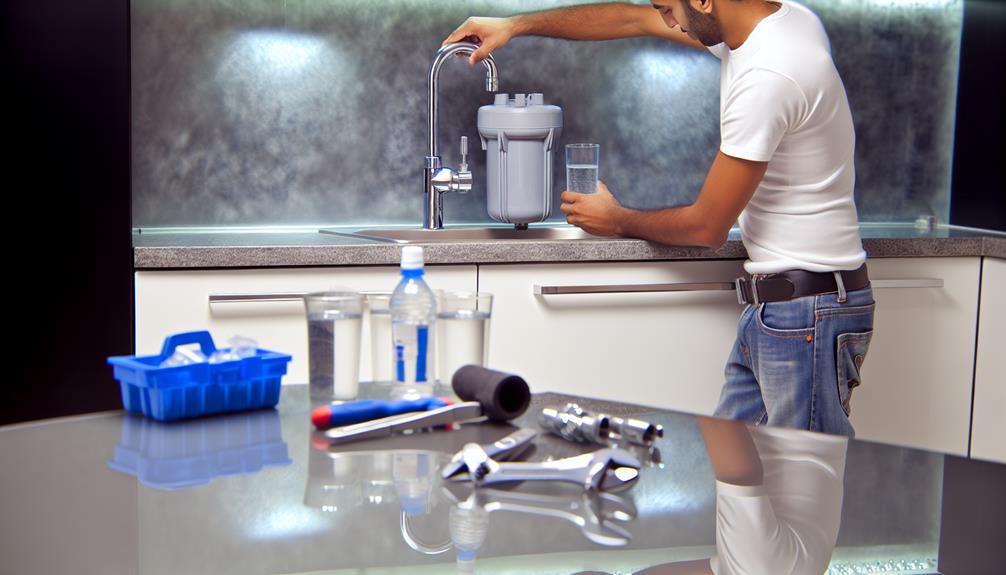Maintaining your whole house filtration system is like tending a garden; it requires regular attention and care to thrive. You've invested in the health and safety of your home's water supply, but without proper maintenance, that investment can wither like an untended rosebush.
Scheduling regular inspections is a cornerstone of keeping your system running smoothly, just as you'd routinely check your car's oil. Remember to monitor your pressure gauges, as fluctuating pressure can signal a need for filter replacement or system adjustments.
Speaking of filters, replacing them in a timely manner isn't just a suggestion—it's a necessity for the longevity of your system. And while these tips may seem straightforward, the devil often lurks in the details.
Each point in your maintenance checklist is a step towards ensuring the purity of your water and the efficiency of your filtration system. But what about those less obvious tips, the ones that could make the difference between a system that functions adequately and one that excels?
Let's explore the nuances that could elevate your maintenance routine from good to great.
Schedule Regular Inspections
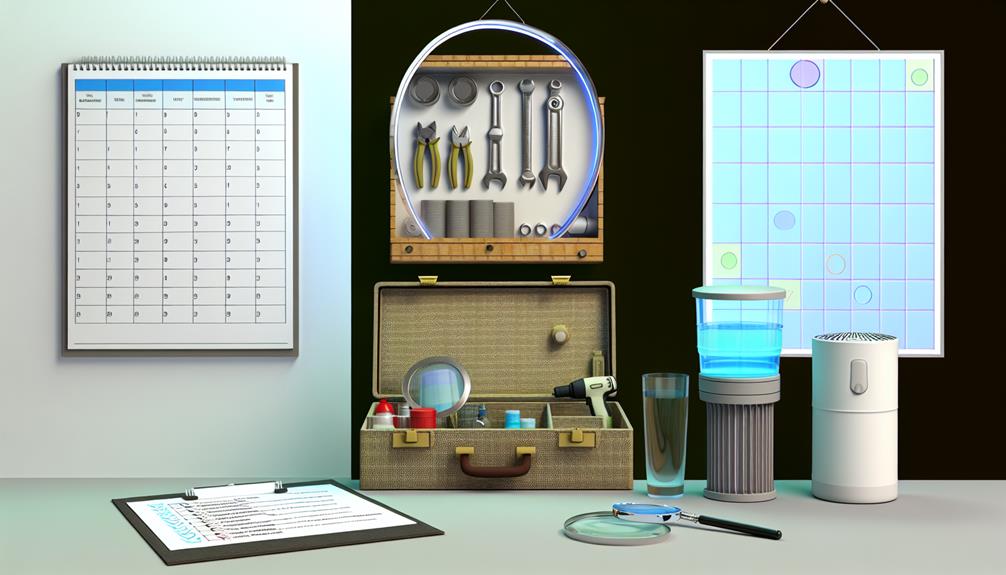
To ensure the longevity and optimal performance of your whole house filtration system, it's crucial to schedule regular inspections at least once a year. Adherence to a consistent inspection frequency not only helps in early detection of potential issues but also ensures that the system is operating at peak efficiency. This proactive measure can save you from costly repairs down the line.
During these inspections, a professional assessment is key. You'll want a certified technician to conduct a thorough evaluation of all components, including filters, tanks, and connections. They'll check for signs of wear and tear, corrosion, or sediment buildup, which could impede water flow or compromise water quality. Additionally, they'll verify that the system's pressure settings are correct and that there are no leaks.
The professional should also review the system's backwash cycle to ensure it's functioning properly. This process is vital for self-cleaning filters, as it flushes out accumulated contaminants and prevents channeling. If your system includes a water softener unit, the technician will assess the brine tank and control valve settings to maintain the proper ion exchange process, extending the life of the resin bed.
Check Pressure Gauges Often
You should frequently check your system's pressure gauges to ensure they're operating within the recommended range.
If you notice significant swings in pressure readings, it's crucial to address these fluctuations promptly.
Consistent monitoring helps you detect potential issues early, preventing costly repairs and ensuring the longevity of your filtration system.
Monitor Gauge Readings
Regularly checking your whole house filtration system's pressure gauges can prevent performance issues and maintain optimal water flow. Gauge accuracy is critical for detecting problems early and ensuring your system operates efficiently. It's not just about the reading itself, but understanding what those readings mean:
- Normal Operating Range:
- *Ideal Pressure:* Confirm that the gauge displays pressures within the manufacturer's recommended range.
- *Consistency:* Look for consistent readings over time to verify system stability.
- Warning Indicators:
- *Sudden Drops:* A significant decrease may signal a leak or blockage.
- *Spikes:* High pressure could indicate sediment buildup or a malfunctioning valve.
Respond promptly to any abnormal gauge readings to safeguard your filtration system's longevity and functionality.
Address Pressure Fluctuations
Monitoring your whole house filtration system's pressure gauges frequently allows for the prompt identification and correction of pressure fluctuations that could compromise water quality and system efficiency. You'll want to keep an eye on the pressure valve, as it's crucial for maintaining stable water flow and protecting the filtration components. Fluctuation causes can range from clogged filters to a malfunctioning pressure regulator.
To ensure accuracy, check the gauges at the same time daily, as pressure can vary at different times. If you notice significant deviations, investigate immediately. A sudden drop might indicate a breach or leak in the system, while a spike could signal an obstruction or a faulty valve. Addressing these issues swiftly will prevent damage to your filtration system and ensure a continuous supply of clean water.
Replace Filters Timely
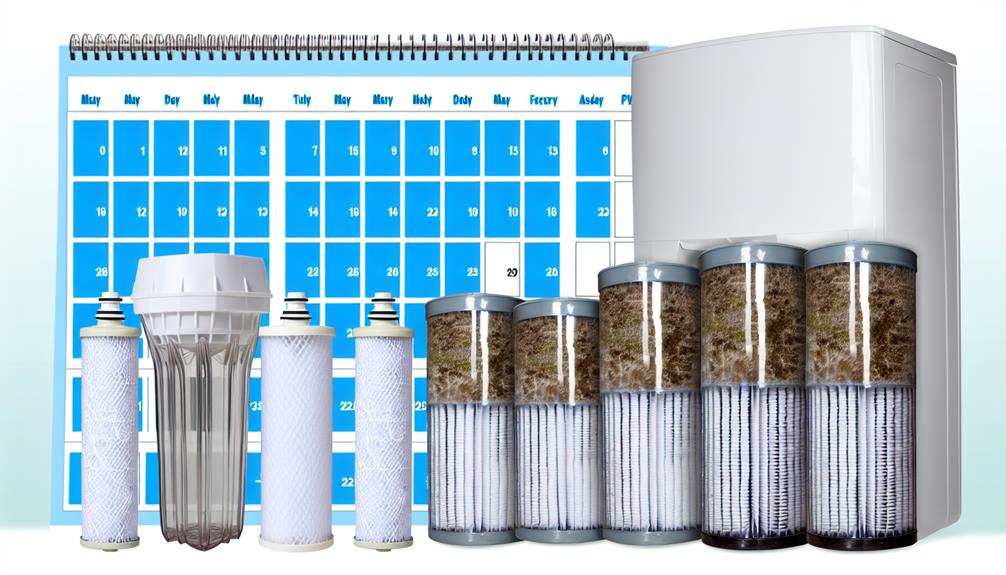
To ensure optimal performance of your whole house filtration system, it's critical to replace the filters according to the manufacturer's recommended schedule. Filter lifespan is a vital consideration in maintaining water quality and system efficiency. Most manufacturers provide a guideline for filter replacement, typically ranging from every three to twelve months, but this can vary based on water usage and sediment levels.
Be mindful of replacement indicators which signal it's time to change your filter:
- A noticeable decrease in water pressure
- Changes in water taste or odor
- Visible sediment in filtered water
Here's what you need to know about timely filter replacement:
- Filter Lifespan
- *Sediment filters:* Often the first line of defense, these may require more frequent changes.
- *Carbon filters:* These target chemical contaminants and have a longer lifespan but still need regular monitoring.
- Replacement Indicators
- *Visual inspection:* Look for discoloration or material breakdown.
- *System monitors:* Some systems feature automatic alerts for filter changes.
Adhering to these guidelines not only prolongs the life of your system but also ensures that you're not compromising on the safety and cleanliness of your home's water supply. Regular replacement is an investment in the longevity and effectiveness of your water filtration system.
Clean Sediment Pre-Filter
You'll need to recognize the signs indicating when your sediment pre-filter requires replacement. These signs may include a noticeable drop in water pressure or visible sediment accumulation. Establishing a regular cleaning schedule is important to ensure that your system operates at optimal efficiency and to extend the life of your main filters. This regular cleaning schedule involves a routine inspection and maintenance process. This process includes disassembling, rinsing, and, if necessary, replacing the pre-filter cartridges.
Identify Filter Replacement Signs
Recognizing when your sediment pre-filter requires replacement is crucial for the continuous efficacy of your whole house filtration system. Filter lifespan isn't infinite, and warning indicators shouldn't be ignored. Be vigilant for signs such as:
- A noticeable decrease in water pressure
- Visible sediment or discoloration in your water
To ensure you're not missing anything important, keep in mind:
- *Manufacturer's guidelines:* Typically, a sediment pre-filter should be changed every 3-6 months.
- However, this can vary based on your water usage and the level of sediment in your water supply.
- *Inspection routine:* Regular visual checks of the pre-filter can alert you to changes.
- If the filter appears clogged or dirty before the usual replacement time, don't hesitate to replace it.
Regular Cleaning Schedule
While keeping an eye on filter replacement signs, it's equally imperative to adhere to a regular cleaning schedule for your sediment pre-filter to maintain optimal performance. Proper filter placement is crucial to ensure that dirt and debris are efficiently captured. You should disassemble the pre-filter housing according to the manufacturer's instructions and use appropriate cleaning agents to remove accumulated sediment without damaging the filter media.
| Cleaning Step | Frequency | Notes |
|---|---|---|
| Visual Inspection | Bi-weekly | Check for clogs or wear |
| Rinse with Water | Monthly | Use gentle pressure |
| Apply Cleaning Agents | Quarterly | Follow manufacturer's guidelines |
| Check Filter Placement | After Cleaning | Ensure proper seal |
| Record Maintenance | Each Cleaning | Log for future reference |
Adhering to this schedule ensures longevity and reliability of your whole house filtration system.
Monitor Water Flow Rate
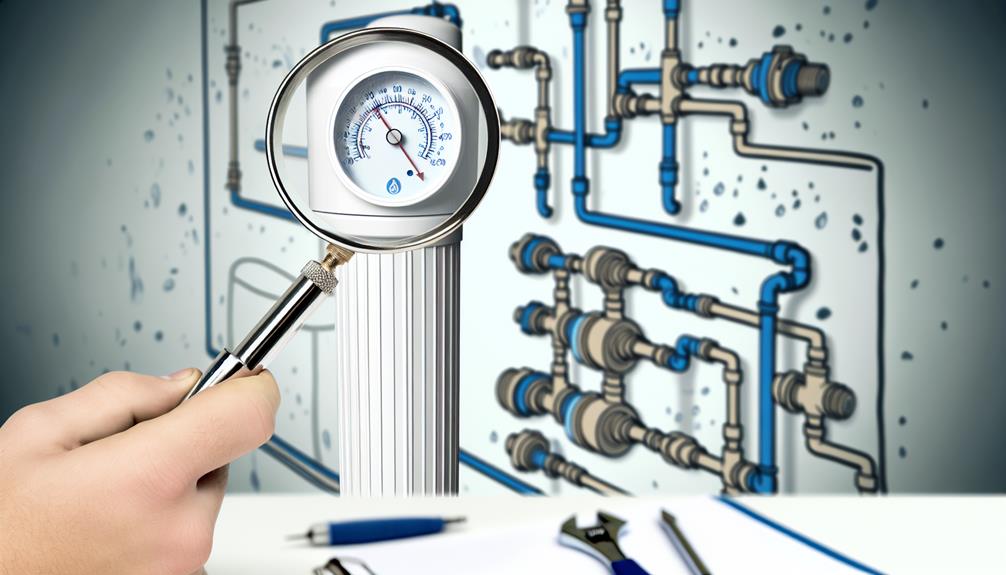
To ensure optimal performance of your whole house filtration system, it's essential to regularly check the water flow rate for any significant changes. Monitoring flow measurement can alert you to a potential issue with the filtration media or signal that a rate adjustment is necessary. Keep in mind that a decline in water flow rate often indicates clogged filters or sediment buildup.
When you monitor water flow, consider the following details:
- Flow Measurement Techniques
- Utilize inline flow meters for real-time monitoring.
- Periodically check the flow manually by timing the fill-up of a fixed-volume container.
- Rate Adjustment Strategies
- Adjust the backwash cycle frequency to maintain optimal flow rates.
- Consult your system's manual for recommended pressure settings and adjust accordingly.
Test Water Quality Regularly
Regular testing of your home's water quality is crucial for detecting contaminants and ensuring the filtration system functions effectively. You should establish a routine testing schedule to monitor for a broad spectrum of water contaminants, including bacteria, heavy metals, and chemical pollutants, which could compromise your health and the integrity of your water supply.
Precise testing kits are available for home use, and it's advisable to employ a variety of these to get comprehensive data on your water's condition. Look for kits that test for common contaminants and align with the Environmental Protection Agency's (EPA) guidelines. This will give you an accurate assessment of your filtration efficacy.
Remember, different contaminants require different filtration methods. If your tests indicate a spike in any particular contaminant, it's possible that your filtration system needs maintenance or that a specific filter media requires replacement. For instance, an increase in sediment could suggest the pre-filter is nearing the end of its lifespan.
Additionally, consider sending a water sample to a certified laboratory annually for a more detailed analysis. This can provide an in-depth profile of your water quality, ensuring that you're not overlooking any less common or emerging contaminants. Regular testing not only protects your health but also prolongs the life of your filtration system.
Sanitize the System Annually
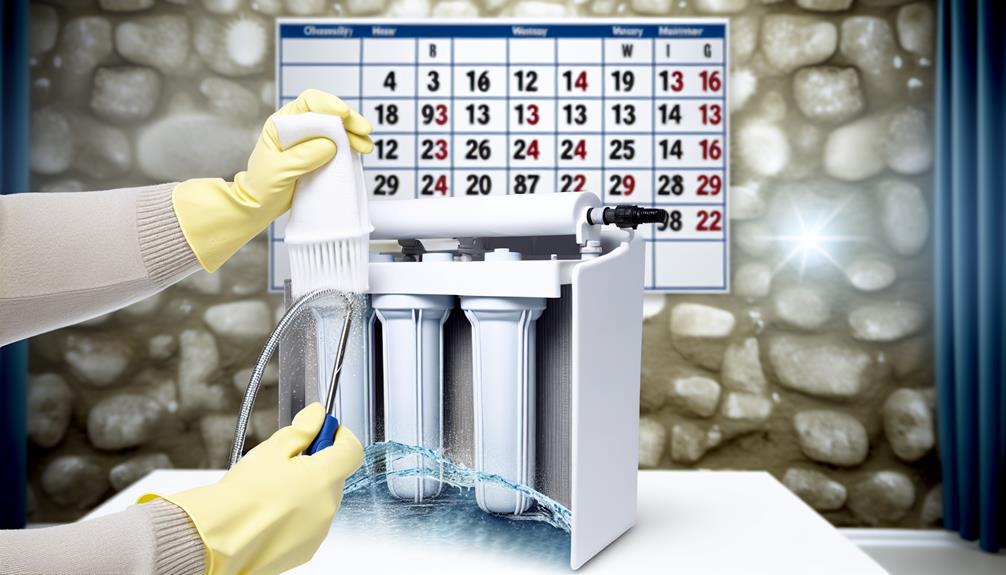
You should schedule a yearly sanitization of your whole house filtration system to prevent microbial buildup and ensure optimal performance.
Selecting the right sanitizers is critical; you must use agents that are effective against a broad spectrum of pathogens and compatible with your system's components.
Follow the manufacturer's guidelines for concentration and contact time to achieve thorough disinfection.
Schedule Regular Sanitization
Ensuring the longevity and efficiency of your whole house filtration system necessitates annual sanitization to prevent microbial buildup and maintain water quality. Adhering to a sanitization frequency is critical to impeding bacterial growth that can compromise the system's performance.
- Annual Sanitization Checklist:
- Inspect and replace filters if necessary.
- Flush the system with a sanitizing solution.
It's essential to mark your calendar or set reminders to perform this maintenance task. Neglecting to sanitize your system can lead to a host of issues, including reduced water quality and potential health risks. Make sure you've read the manufacturer's guidelines for the proper sanitization procedure or consider hiring a professional to ensure it's done correctly.
Choose Appropriate Sanitizers
While setting reminders for your annual system sanitization, it's equally important to select the correct sanitizers tailored for your whole house filtration system to guarantee optimal disinfection. Sanitizer compatibility is paramount; using an incompatible chemical can damage your system or be ineffective against certain contaminants. Always consult your system's manufacturer guidelines to ensure you're using an approved sanitizer that won't harm the components.
Pay attention to the chemical concentration as well. A sanitizer that's too diluted may not effectively kill bacteria and viruses, while an overly concentrated solution could corrode your system's parts or leave harmful residues. Measure the sanitizer accurately according to the manufacturer's instructions, and distribute it evenly throughout the system to achieve thorough and safe sanitation.
Look for System Leaks
Regularly inspect your whole house filtration system for any signs of leakage, as these can compromise both water quality and system efficiency. Leak indicators aren't always as obvious as a pool of water; you'll need to be vigilant for subtler signs as well. Look for damp spots, corrosion on pipes, or a musty smell around the system. If you find a leak, it's essential to act promptly to prevent further damage.
- Leak indicators to watch for:
- Unexplained increase in water bills
- Water meter changes when no water is being used
- Immediate steps to take:
- Shut off the main water supply
- Dry the area and clean any standing water to prevent mold growth
Once you've identified a leak, assess whether it's within your capability to repair it. If it's a minor issue, you might be able to fix it with a repair kit from your local hardware store. These kits typically include items like seals, O-rings, and plumbing tape. However, for more complex leaks or if you're unsure about the repair, it's wise to consult a professional.
Maintain the Surrounding Area
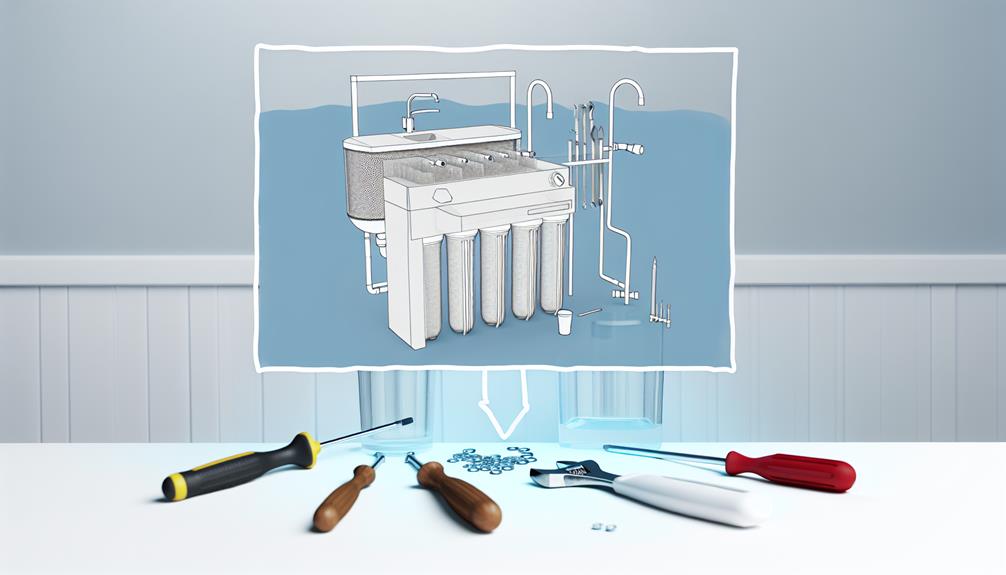
To prevent system inefficiencies and potential hazards, it's crucial to keep the area around your whole house filtration system clear and well-maintained. Ensuring proper space clearance not only facilitates easy access for maintenance and inspection but also promotes adequate area ventilation, which is essential for the system's operation and longevity.
Firstly, you should maintain a minimum clearance around the filtration unit as recommended by the manufacturer. This space is necessary for airflow and heat dissipation, which helps prevent overheating. Verify that the specific clearance guidelines are met and consistently upheld, especially after storing items or housekeeping near the system.
It's also vital to check that the ventilation in the space housing your filtration system is sufficient to allow for any off-gassing or to dissipate excess moisture. Poor ventilation can lead to mold growth and corrosion, significantly shortening the lifespan of your system components. If the area lacks natural airflow, consider installing vents or using dehumidifiers to improve air quality.
Regularly remove any debris, dust, or other obstructions that may accumulate around the system. This not only contributes to improved performance but also mitigates any fire risk associated with flammable materials coming into contact with the system.
Flush the System Periodically
To ensure your whole house filtration system operates at peak efficiency, it's crucial you schedule regular flushing intervals.
Flushing the system helps remove accumulated sediment and contaminants that can hinder performance.
Understanding the benefits of system flushing will extend the lifespan of your filters and maintain water quality.
Schedule Regular Flushing
Ensure your whole house filtration system operates at peak efficiency by scheduling periodic flushing to remove accumulated sediments and contaminants. Flushing your system is crucial, and understanding the flush timing and flushing methods is essential to maintaining performance:
Flush Timing:
- Aim for at least every 6 months, or as recommended by the manufacturer.
- Monitor water clarity and pressure drop as indicators for earlier flushing.
Flushing Methods:
- Manual flushing involves opening the flush valve until water runs clear.
- Automated systems may have programmable features to flush at set intervals.
Adhering strictly to these guidelines won't only prolong the life of your filtration system but also ensure the consistent quality of your water supply.
Benefits of System Flushing
Flushing your whole house filtration system periodically offers significant benefits, including enhanced performance, prolonged lifespan of the system, and consistent water quality. System longevity is directly influenced by the removal of accumulated particles and sediment through regular flushing. This process prevents clogging and maintains the filtration media's efficacy, ensuring that your water remains safe and clean.
Determining the optimal flushing frequency depends on several factors, such as water usage and the quality of your water supply. Typically, manufacturers provide a recommended schedule, but you should also monitor the system's performance and pressure drop to adjust as necessary.
Adhering to a routine flush not only preserves the functionality of your filtration system but also maximizes its efficiency, safeguarding your investment in whole house water treatment.
Update Seals and O-Rings
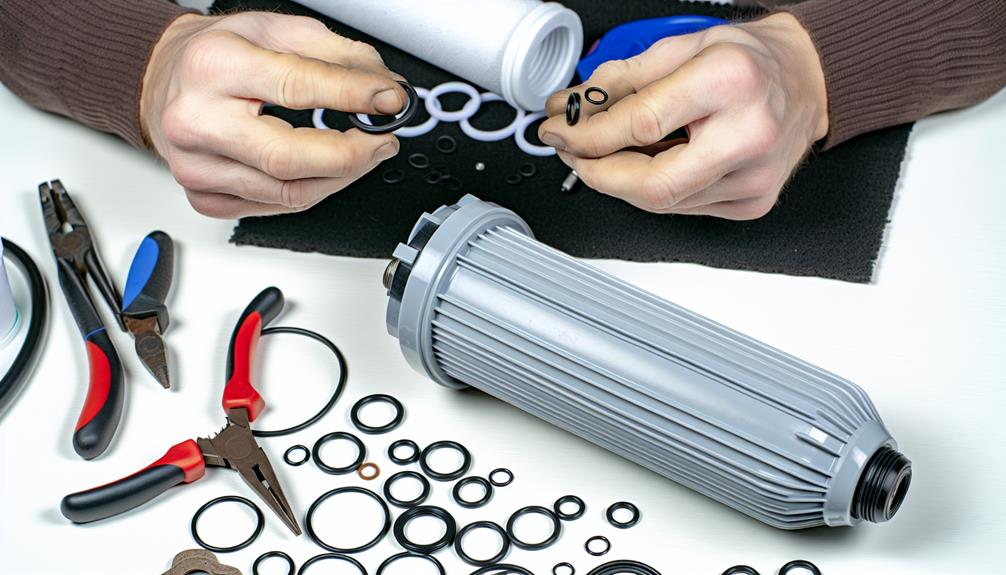
Regularly inspecting and replacing worn seals and O-rings is crucial for preventing leaks in your whole house filtration system. Over time, these components can degrade, leading to potential seal failures and water damage. To ensure the longevity and effectiveness of your seals and O-rings, you need to follow proper maintenance practices, including seal lubrication and appropriate O-ring storage.
When it comes to maintaining these critical components:
- Seal Lubrication
- Use a manufacturer-approved lubricant to maintain the seal's flexibility and create a tight fit.
- Avoid petroleum-based lubricants if your seals are made of rubber, as they can cause the material to swell and fail.
- O-Ring Storage
- Keep O-rings in a cool, dark place away from direct sunlight, as UV rays can degrade the material.
- Store them flat and avoid kinking or bending, which can lead to permanent deformations and ineffective seals.
Remember to check the condition of the seals and O-rings every time you service your filtration system. If you notice any signs of wear, such as cracking, brittleness, or deformation, it's time to replace them. Always have spare seals and O-rings on hand to avoid system downtime during routine maintenance.
Protect Against Freezing
To protect your whole house filtration system from the damaging effects of freezing temperatures, it's essential to implement preventative measures before cold weather sets in. Freezing can cause pipes to burst, leading to potential flooding and costly repairs.
Insulation solutions are your first line of defense against the cold. Using foam pipe insulation, you can cover exposed pipes connected to your filtration system. Make sure to cut the insulation to the correct length and secure it with durable tape, ensuring a snug fit around the pipes. This will greatly reduce the risk of freezing by retaining the heat within the pipes.
Additionally, heat tape usage can provide extra protection in particularly vulnerable areas. Wrap self-regulating heat tape around the pipes, taking care not to overlap the tape, as this can lead to overheating. Once applied, cover the heat tape with pipe insulation for better efficiency. Always follow the manufacturer's instructions when applying heat tape to prevent any mishaps.
You'll also want to maintain a consistent thermostat setting to keep the ambient temperature above freezing. In severe cold snaps, consider letting a faucet slowly drip overnight to keep water moving, which helps prevent freezing.
These strategic steps can safeguard your filtration system against winter's chill.
Balance Water Ph Levels
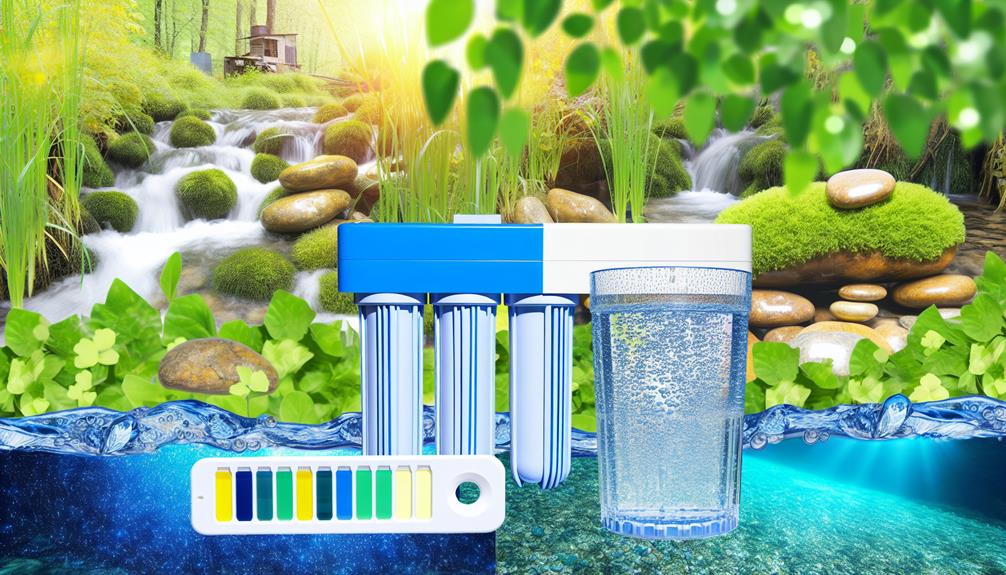
Ensuring your whole house filtration system maintains balanced pH levels is crucial for preventing corrosion and scale buildup within your pipes and appliances. Regular monitoring of water pH is essential, and you can do this using pH testing kits, which are simple and effective. Here's how to keep your water pH perfectly balanced:
- Conduct Regular pH Testing
- Utilize pH testing kits to gauge the acidity or alkalinity of your water.
- Aim for a pH level between 6.5 and 8.5, which is generally considered safe for most household uses.
If you find your water's pH is too acidic, it's time to consider acidic remedies to neutralize the pH levels. Calcite filters or soda ash injections can raise the pH of acidic water. Here's a concise guide:
- Neutralize Acidic Water
- Calcite filters: Use these to add calcium carbonate to the water, increasing the pH naturally.
- Soda ash systems: Inject a solution of sodium carbonate, which reacts with the acidity in the water to raise the pH.
Manage Disposal of Old Filters
When replacing old filters from your whole house filtration system, it's essential to properly dispose of them to prevent environmental contamination and adhere to local disposal regulations. Filter disposal regulations can vary by region, so you'll need to check with your local waste management authority to understand the specific requirements.
Most filters, especially those used in whole house systems, aren't recyclable through curbside programs due to the contaminants they've collected and the mixed materials they're composed of. However, some manufacturers have take-back programs or recycling initiatives for their products. Investigate whether the brand of your filters offers such a service.
For filters that can't be recycled, you must dispose of them as directed by local regulations. Often, this means placing them in your regular trash. To minimize environmental impact, seal the filter in a plastic bag to contain any residual particles or water that could leak out. If your filter contains activated carbon, which is beneficial for soil amendment, you might be able to empty the carbon into your compost or garden, but only if it's free from pollutants.
Always wear gloves and a dust mask when handling used filters to protect yourself from potential contaminants.
Keep a Maintenance Record
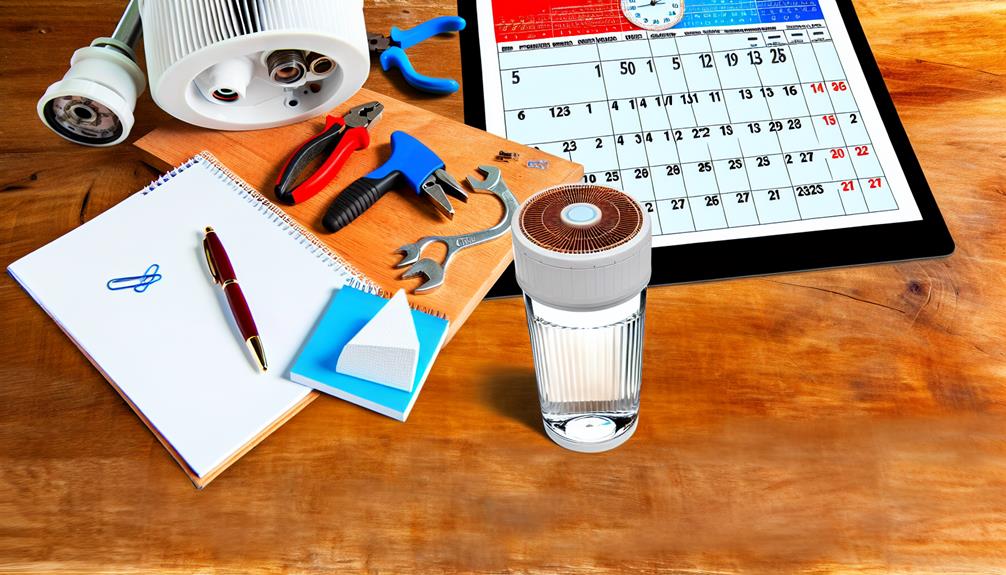
Keeping a detailed maintenance record for your whole house filtration system helps you track filter changes, system performance, and maintenance schedules effectively. In the realm of record organization and maintenance documentation, precision is key. You should note every inspection, alteration, or replacement that occurs within your system. This log not only serves as a historical reference but also aids in diagnosing future issues should they arise.
For optimal record-keeping, consider the following structure:
- Maintenance Documentation:
- Date of service or inspection
- Specific actions taken (e.g., filter replacement, part lubrication)
- Any anomalies or issues noted
- The name of the individual performing the maintenance
- Expected date for the next service
- Record Organization:
- Chronological ordering of entries
- Use of tabs or sections for different system components
- Accessibility for quick reference during emergencies or routine checks
Conclusion
In conclusion, you've got to stay on top of your whole house filtration system to keep it running smoothly. Regularly inspect the unit, monitor pressure gauges, and replace filters as needed.
Don't forget to clean the pre-filter, watch the flow rate, and shield it from freezing temps. Keep the pH balanced, dispose of old filters properly, and meticulously log all maintenance.
Following these technical, detailed tips ensures your system works efficiently, providing you with clean, safe water.
